Comprehensive Overview of Open Dental Support Solutions


Intro
In the bustling world of dental practices, managing patient information, scheduling, and billing efficiently is crucial. Open Dental emerges as a robust solution in this domain, capturing the attention of both small clinics and larger dental institutions. With its open-source foundation, it not only allows customization but also fosters a community-driven approach to software development, which can be immensely valuable for users looking for flexibility.
The increasing complexity in dental care, alongside the rapid evolution of technology, calls for software that can keep pace. This article will dissect the features and support options Open Dental offers and how they can contribute to more effective practice management. From a basic understanding of its functionalities to insights on user experience, we aim to equip IT professionals, software practitioners, and business owners with the information needed to navigate this dental software landscape effectively.
Software Overview
Software Description
Open Dental is designed with the intent to provide dental practices with tools that cater to their specific needs. Unlike many proprietary systems, its open-source nature allows practices to modify and expand its capabilities according to their unique workflows. This means that practices can have software that adapts to them rather than forcing them to change how they operate. The software supports a myriad of features aimed at enhancing office efficiency and patient care.
Key Features
Open Dental packs a punch with a range of features:
- Patient Management: Keep track of patient records including medical histories, treatment plans, and appointments. This centralization is crucial for creating seamless interactions between staff and patients.
- Scheduling System: Offers intuitive scheduling tools that allow staff to manage appointments effectively, reducing no-shows and improving office workflow.
- Billing and Insurance: Automates the billing process, making it easier to handle multiple insurance claims, simplifying revenue cycle management.
- Electronic Health Records (EHR): Facilitates the creation and maintenance of comprehensive electronic health records, ensuring compliance and enhancing access to patient data.
- Customization Options: Users can modify the software interfaces and functionalities as per their needs, allowing for an adaptable software experience.
Each of these components works synergistically to streamline the management of dental practices, offering users a comprehensive solution that caters to both operational and patient care needs.
User Experience
User Interface and Design
The interface of Open Dental strikes a balance between functionality and aesthetics. It is designed to be user-friendly while accommodating complex features. Users often find the layout of the dashboard helpful, delivering access to essential tools with minimal clicks. The intuitive design helps in reducing the learning curve for staff, enabling them to adapt quickly to new workflows.
Performance and Reliability
Performance-wise, Open Dental earns commendations from users for its reliability. Patients’ records and appointment schedules are accessible swiftly, which is vital in a dental practice where efficiency is key. Additionally, the community around Open Dental continually works on improving the software, ensuring that it remains up-to-date with the latest technological advancements. Regular updates help maintain security and performance, reinforcing trust among its users.
"Open Dental’s vitality lies in its community-driven approach, which keeps it aligned with evolving dental practices and technology needs."
In summary, the blend of intuitive design and dependable performance makes Open Dental a software choice that aligns well with modern dental practice demands. Users can focus more on patient care and less on administrative hassles, paving the way for a more efficient and effective practice.
For further reading and insights into Open Dental and its evolving ecosystem, visit the following links:
With this foundational understanding, the article continues to explore the advantages and considerations surrounding Open Dental, elaborating on its support network and integration capabilities.
Preface to Open Dental Support
In the continuously evolving field of dental practice management, Open Dental has carved out a unique position for itself as a go-to solution for many practitioners. This open-source software delivers flexibility and adaptability that proprietary systems often lack. Understanding Open Dental Support is vital for dental practitioners and IT professionals who want streamlined operations and enhanced patient experiences. The adoption of Open Dental not only improves efficiency but also fosters a culture of innovation within dental practices.
Open Dental Support encompasses a range of functionalities designed to enhance the overall effectiveness of dental software management. The ability to customize features to fit the unique needs of a practice is a significant advantage, allowing dental teams to focus more on patient care rather than administrative hurdles. Support options available for Open Dental are not just about troubleshooting; they also cultivate a community where practitioners share experiences and solutions.
"Open source is about more than software; it's about collaboration and the sharing of ideas."
For many dentists, a robust practice management tool is essential yet can come with its own set of challenges. Understanding how to optimize software like Open Dental requires thorough knowledge of its capabilities. This section will delve into the key elements that define Open Dental Support, its benefits, and some considerations dental practices may face during its implementation.
Understanding Open Dental Software
Open Dental stands out in the crowded dental software marketplace for its open-source nature, allowing users to access, modify, and improve upon the codebase as needed. This means practices can tailor their software environment to their specific requirements without being beholden to a single vendor's direction. The user interface is designed to facilitate daily tasks efficiently, supporting everything from patient scheduling to billing with ease. Additionally, end-users have control over updates, thereby stripping away the overhead of unnecessary features that are often bundled into commercial software.
Importantly, Open Dental integrates with many other platforms and tools, making it a versatile choice for practices aiming to create a cohesive administrative ecosystem. As the world trends toward integrated solutions, dental practices leveraging this software are better prepared to meet the demands of both patients and regulatory bodies.
The Concept of Open Source in Dental Software
The term "open source" is often tossed around in tech circles, but understanding its implications in dental software can unlock the real potential of systems like Open Dental. Open source means that the software's source code is available to anyone who wishes to inspect, modify, or enhance it. This transparency fosters an environment of collective problem-solving, something that is somewhat absent in traditional software setups.
Practices benefit from the contributions of a global community of developers and users who share enhancements and fixes, often tailoring solutions that align closely with evolving dental regulations. This is a significant plus, considering that dental practices frequently find themselves responding to new clinical and operational requirements.
Moreover, open source tools typically come with lower upfront costs compared to their closed counterparts. This is a crucial consideration for small dental practices, which may find high license fees prohibitive. With Open Dental, practices can allocate their financial resources toward patient care and other essential services, rather than sinking funds into expensive software licenses.
The open-source model also promotes innovation. As practitioners interact with and shape the software based on their needs, the potential for groundbreaking improvements grows. Given the constant shifts in technology and consumer expectations, keeping pace with change is not just beneficial—it's essential.
Key Features of Open Dental
The realm of dental management software has evolved significantly, leading to the emergence of robust solutions like Open Dental. Understanding its key features not just sheds light on its functional prowess, but also on its importance in streamlining practice operations, enhancing patient experience, and offering ease of use. In this section, we will explore specific facets of Open Dental that make it a preferred choice for practitioners.
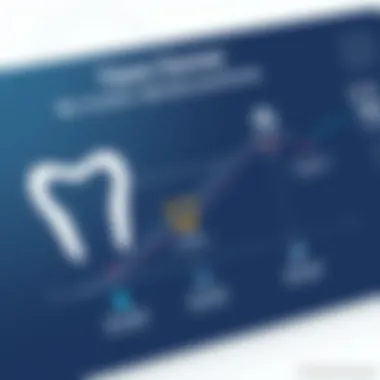
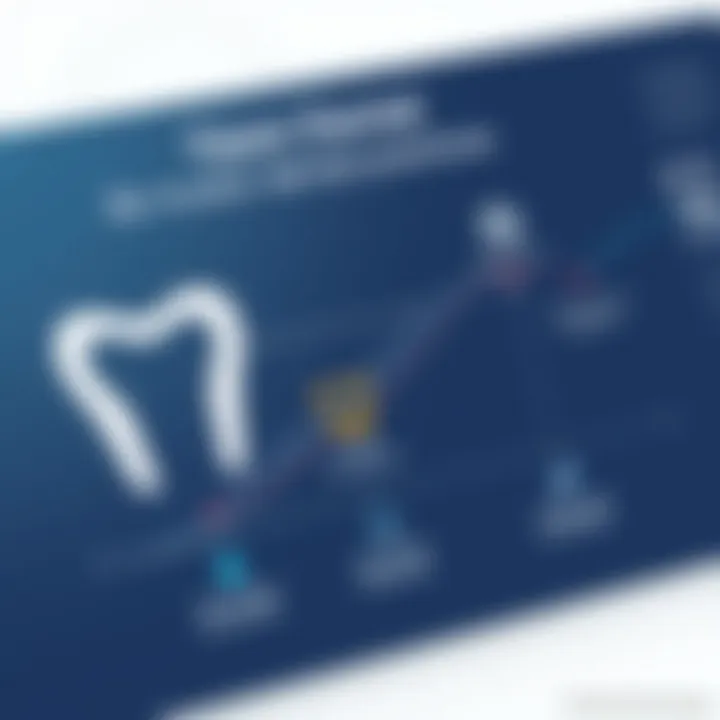
Comprehensive Practice Management
Open Dental boasts an all-inclusive practice management system that caters to a variety of operational needs. From managing patient records to keeping track of treatment histories, it encompasses every area crucial for daily practice management.
Some significant elements include:
- Intuitive User Interface: The design is not just aesthetically pleasing; it’s geared towards usability, allowing staff to navigate effortlessly.
- Patient Records Management: Comprehensive digital dental records help practitioners access vital information quickly, ensuring more informed decision-making.
- Treatment Planning: The flexibility to customize treatment plans helps practitioners meet unique patient needs effectively.
These facets collectively boost productivity, allowing dental professionals to focus on what really matters—the care they provide to their patients.
Appointment Scheduling Flexibility
In the dental world, time is often of the essence. Open Dental offers versatile appointment scheduling that caters to varying needs of both the practice and patients. The software allows for:
- Block Scheduling: This feature permits dental offices to manage time efficiently by setting aside blocks for specific types of procedures, streamlining the workflow.
- Patient Reminders: Automatic reminders via email or SMS reduce missed appointments, enhancing practice efficiency.
- Online Scheduling Options: Patients can book, cancel, or reschedule appointments at their convenience, promoting a user-friendly experience.
Such flexibility in scheduling not only enhances patient engagement but also optimizes appointment management, reflecting a diligent operation.
Billing and Insurance Management
Managing billing and insurance claims can resemble navigating a labyrinth for many dental practices. Open Dental addresses this challenge head-on with its sophisticated billing and insurance management tools:
- Integrated Billing: The software allows for seamless billing processes, reducing errors and simplifying financial management.
- Insurance Claims Management: Open Dental streamlines the submission of claims, enabling practices to expedite reimbursements.
- Tracking Payments: Users can track outstanding balances effectively, ensuring no revenue is left on the table.
An organized system of billing and insurance management helps practices maintain healthy cash flow, which is paramount for any business.
Patient Communication Tools
Effective communication is the lifeblood of any successful dental practice. Open Dental enhances patient engagement through a variety of communication tools. These tools serve multiple functions:
- Patient Portals: Patients gain access to their records, treatment plans, and communications all in one place, promoting transparency.
- Automated Communication: Automated emails and text messages help keep patients informed regarding appointments, outstanding balances, and treatment plans.
- Feedback Mechanisms: Gathering patient feedback through surveys or direct communication can lead to improved services and patient satisfaction.
Strong communication channels not only build trust but also facilitate better patient retention, making them essential in today's competitive landscape.
"The true hallmark of a successful dental practice is not just in patient acquisition; it's in fostering long-standing relationships through effective communication."
In summation, the key features of Open Dental not only streamline everyday tasks but also position practices for long-term success by enhancing overall patient experiences and operational efficiencies. Incorporating these features into daily practice management can lead to more satisfied patients and a healthier bottom line.
For further reading, you might find valuable insights at Wikipedia and Britannica..
Advantages of Using Open Dental
When diving into the realm of Open Dental, it's crucial to understand the distinct advantages it brings to the table. The importance here isn’t just about software; it’s about empowering dental practices to optimize operations, improve patient care, and manage resources more efficiently. In a turbulent economy, where every penny counts, the decision to adopt a solution like Open Dental can lead to substantial savings and better service delivery. Below are three major advantages that stand out immensely.
Cost-Effectiveness of Open Source Solutions
The cost-effectiveness of Open Dental lies primarily in its open-source nature. Unlike proprietary software, which can saddle practices with hefty licensing fees, Open Dental alleviates that burden. Clinicians can access a powerful suite of tools with minimal initial expenditure. That’s what you call a win-win!
- No Licensing Fees: There are no annual or monthly subscription charges, allowing practices to allocate funds to other critical areas, such as staff training or equipment upgrades.
- Long-Term Savings: As the software necessitates fewer financial resources for updates and maintenance, practices can enjoy continued savings as time goes on.
- Community-Driven: Many developers contribute to enhancing the software, meaning that innovations and updates arise at no extra cost, which other software companies wouldn’t dream of offering without an additional fee.
So, when considering the bottom line, Open Dental's open-source philosophy speaks volumes in terms of cost savings.
High Customizability and Control
With Open Dental, businesses are not just users; they're also contributors, sculpting the software to fit their unique needs. The high customizability factor can be a breath of fresh air in an otherwise rigid software landscape.
- Tailored Solutions: Practices can implement specific features that suit their workflow without being confined to a one-size-fits-all approach. For instance, a dental practice can customize templates to integrate unique clinical workflows or reporting requirements.
- Control Over Data: Users are typically vaults of their patient data. This level of control is paramount in modern healthcare, mitigating risks associated with data breaches and unauthorized access.
An open-source solution gives practices the reins to mold their systems and processes, aligning perfectly with their goals and needs, much like a tailor-made suit.
Robust Community and Peer Support
One of the often-overlooked advantages of Open Dental is the incredible community that backs it. The robustness of this community forms a safety net and an innovation hub for practitioners.
- Community Forums: Open dialogue takes place in various forums where users discuss solutions, share experiences, and offer troubleshooting tips. This interactivity can be invaluable for a practice when grappling with an issue.
- User-Created Content: Many users have shared plugins, extensions, and even training guides. This type of collaboration enhances the user experience and provides insights that might be missed in traditional support scenarios.
"In the world of dental software, community power is a game changer, powering growth and innovation every step of the way."
In summary, the advantages of using Open Dental extend well beyond mere functionality. The cost savings, customization, and community support set it apart in a competitive field. These elements interweave to create a supportive framework that empowers dental practices to thrive, paving the way for innovation and improved patient care.
User Support Options for Open Dental

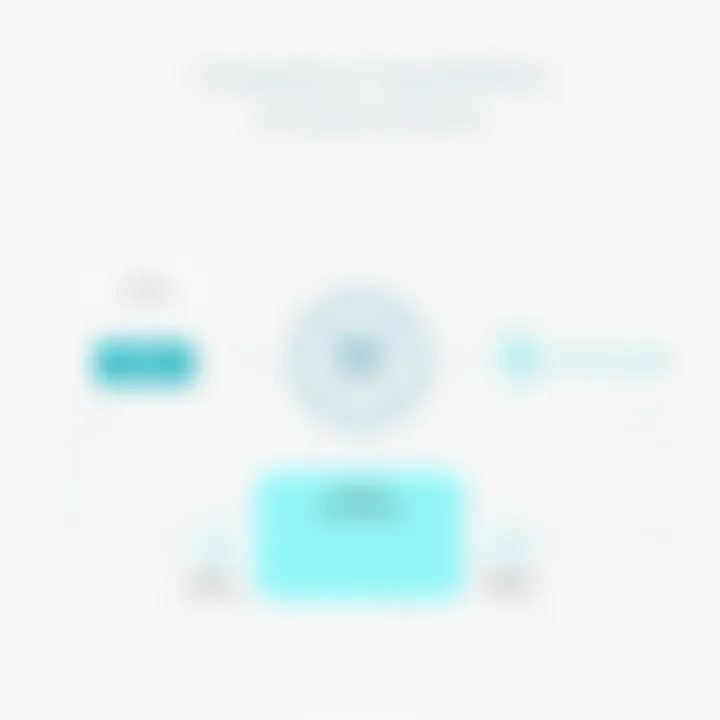
Navigating the world of dental software can be a daunting task, especially for practices considering the switch to Open Dental. The effectiveness and efficiency of any software are largely dependent on the support options available to users. With Open Dental, the focus on user support options underscores their commitment to providing a robust framework for dental professionals. This not only helps in easing the transition to a new system but also ensures long-term satisfaction and operational efficiency.
The real pizzazz of Open Dental shines through its multiple user support avenues. Whether you need answers to quick queries or in-depth guidance on how to master the software, these support options cover all bases, addressing the needs of both novices and seasoned users. Different practices will find various resources invaluable, particularly if they are transitioning from other systems or aiming to leverage Open Dental's extensive features effectively.
Community Forums and Resources
One of the most engaging support options is the community forums associated with Open Dental. Here, users can interact, share insights, and seek advice from fellow practitioners and IT professionals who have walked the same path. The forums are rife with discussions that range from troubleshooting specific issues to sharing tips about advanced functionalities. This community-driven approach not only fosters collaboration but also gives users a sense of being part of something larger.
Resources available in community forums include:
- User-generated Manuals: Many users compile unofficial guides and tips, which can be a goldmine of practical advice.
- FAQs and Troubleshooting Threads: Common issues and their solutions are discussed here, saving users time and frustration.
- Feature Requests and Suggestions: Users can voice their opinions on desired features, which in turn shapes future updates and iterations of the software.
These forums act as a living repository of knowledge where experiences and solutions are exchanged, creating a culture of support that is invaluable for any practice navigating the labyrinth of dental software.
Professional Training and Webinars
Learning a new software can be akin to learning a new language. Open Dental recognizes this challenge and offers professional training and webinars to bridge the gap between novice users and software experts. These sessions provide an in-depth look at various functionalities, ensuring that practices can harness the full potential of the software.
Training options include:
- Live Interactive Webinars: Participants can interact with trainers, ask questions, and even participate in live demonstrations, creating an immersive learning experience.
- On-demand Sessions: For those with hectic schedules, recorded webinars allow users to learn at their own pace, covering everything from basic navigation to advanced customization.
- Certification Programs: For practices looking to fully integrate Open Dental into their workflow, certification programs can provide a structured learning path, further enhancing staff skills.
By providing access to these tailored training resources, Open Dental ensures that organizations can operate smoothly, reducing the learning curve and increasing overall productivity.
Technical Support Services
While community support and training are crucial, sometimes you need a direct line to experts. Technical support services offered by Open Dental are well-structured and accessible, geared toward tackling more intricate issues that may arise during use.
The technical support includes:
- Help Desk Access: Users can submit tickets for issues that require detailed attention, which is routed to experienced support personnel to resolve the matter efficiently.
- Remote Assistance: In some cases, professionals can view your screen directly, facilitating resolution of complex issues that can be hard to explain through text alone.
- Regular Updates and Maintenance: Ongoing support also includes software updates that ensure users are protected against bugs and vulnerabilities.
It's vital for practices to have access to responsive technical support. The assurance that help is only a call or click away can make all the difference, especially in high-stress situations where patient care is on the line.
In summary, the comprehensive user support options provided by Open Dental fortify the practice's capability to operate smoothly and efficiently. Whether it is through community forums, professional training, or technical support services, these resources are designed to enhance user experience and ensure that dental professionals are equipped to deliver exceptional patient care. The attention to user support reflects Open Dental's understanding of the industry's needs and their commitment to advancing dental practice through technology.
"A well-supported user is a confident user, and confidence is key in providing quality patient care."
Considering Implementation Challenges
The adoption of Open Dental software can indeed reshape how a dental practice operates. However, moving forward with this transition isn’t without its hurdles. Understanding the implementation challenges is crucial for ensuring a smooth integration and maximizing the benefits that open-source software offers.
Migration from Existing Systems
When a dental practice decides to switch to Open Dental, one of the first things to consider is the migration from existing systems. This process can be likened to moving houses; while it offers a chance for a fresh start, the effort needed to pack, transport, and unpack everything shouldn’t be underestimated.
Practices may find that data conversion can be complex. There is often a need to import patient records, treatment histories, and billing information. Each of these typically resides in various formats.
- The first step is to:
- Assess Current Data: Take stock of what information is essential and clean it up. Old and redundant data can clutter the new system.
- Use Migration Tools: Open Dental often provides tools that assist in data migration. Knowing how to use them can save time and reduce errors.
- Test Importing Procedures: Running a test import can be very helpful. It allows practice managers to see how data translates and find issues before a full switch.
One should prepare for some downtime during this transition. Informing patients in advance helps maintain trust and avoids disruptions in service delivery.
Training Staff and Technicians
Another vital aspect of implementation is training staff and technicians. The shiny new software can be a powerful tool, but if those who are meant to use it aren't familiar with its functionalities, its potential remains largely untapped.
- Tailored Training Programs: Training must be specific to various roles within the practice. A front desk receptionist won’t require the same depth of knowledge as a dental hygienist. Setting up training sessions focusing on relevant features can be very effective.
- Hands-On Workshops: Consider hosting interactive workshops. They provide participants a chance to practice using the software in a controlled environment, ultimately boosting their confidence.
- Access to Materials: Offering access to manuals, online tutorials, and community forums can provide staff with valuable resources for continuing education post-initial training.
Investing time in training can pay off significantly in day-to-day operations. When staff feels competent using Open Dental, misunderstandings and errors can dwindle, leading to a more harmonious workspace.
Ongoing Maintenance and Updates
Even after successfully migrating and training staff, ongoing maintenance and updates are crucial components that shouldn’t be overlooked. Software isn’t a one-and-done deal; like a car, it needs regular check-ups to ensure it runs smoothly.
- Regular Updates: Open Dental continuously evolves, often rolling out updates and new features. Keeping the software updated ensures that you benefit from the latest functionalities and security patches.
- Scheduled Maintenance: Setting aside time for periodic maintenance checks can help catch issues before they escalate. This includes assessing system performance, checking for bugs, and ensuring proper backup protocols are followed.
- User Feedback and Adaptation: Encourage end-users to express their experiences using the software. Their feedback can guide necessary adjustments or highlight features that may need further training or documentation.
Engaging in proactive maintenance keeps the practice running efficiently, maximizing the benefits of the Open Dental system while mitigating potential disruptions.
"A stitch in time saves nine." Regular maintenance and meticulous implementation can save countless headaches down the road.
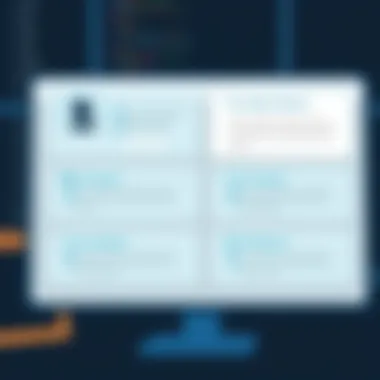
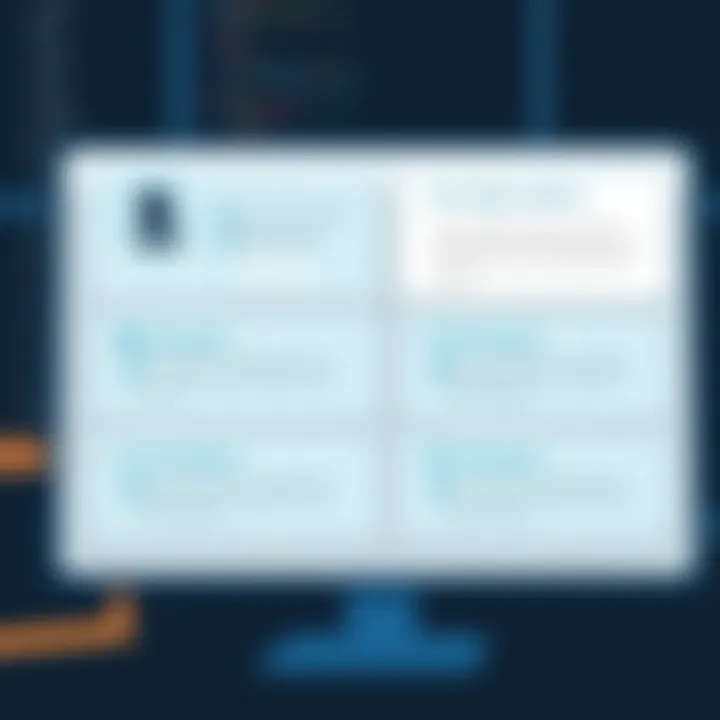
Integration with Other Software Systems
In today's fast-paced dental practice environment, the ability to seamlessly integrate software systems cannot be overstated. Providers increasingly seek solutions that not only cater to their specific operational needs but also play well with existing tools. Open Dental embodies this integration ethos, making it easier for practitioners to streamline their workflows and reduce redundancy.
Compatibility with Existing Tools
When dental professionals decide to adopt new software, questions regarding interoperability often arise. Open Dental stands out by offering a flexible architecture that accommodates various existing platforms. This compatibility is crucial, particularly for practices that have invested significantly in systems like Electronic Health Records (EHR) or Practice Management Systems (PMS).
- Commonly Used Systems
- Dentrix
- EagleSoft
- SoftDent
Utilizing Open Dental, practices can find a bridge between these well-known applications and their newest tools without having to start from scratch. It means existing data can be transferred smoothly with minimal hassles, maintaining continuity and keeping patient histories intact. Such integration not only saves time but also enhances the quality of the care provided. It is worth mentioning that when tools talk to each other, evaluation and documentation become more efficient, leading to a better patient experience overall.
API Capabilities and Extensions
Open Dental’s Application Programming Interface (API) capabilities forge a pathway for innovations and customized enhancements. Its open-source nature means developers are free to create extensions or applications that make Open Dental even more robust. For practices, it opens the door to a treasure trove of options.
By allowing access to underlying operations, the API makes it possible for practices to develop bespoke integrations tailored to their specific needs. Automation of mundane tasks, linking with third-party applications, or even developing entirely new functionalities are among the many repositories of opportunities offered here.
This flexibility serves as a cornerstone for practices to both optimize workflows and innovate. Some common extensions include:
- Integration with imaging software
- Custom reporting tools
- Patient portals
The opportunity to tailor Open Dental directly impacts business outcomes, essentially allowing dental practices to stay nimble and responsive to both market demands and technological advancements.
"Integration isn't just a feature, it's a commitment to changing how we manage and deliver dental care."
The focus on integration with other software systems in Open Dental reflects a broader trend toward interconnected health ecosystems. As the industry moves increasingly into digital transformations, ensuring that tools do not exist in silos but rather communicate effectively with each other is crucial for enhancing overall efficiency and patient satisfaction.
Trends in Dental Software Solutions
As the dental field continues to evolve, dental software solutions are at the forefront of this transformation. The trends in dental software solutions highlight critical elements that not only drive efficiency but also enhance the patient experience. In this article, we'll delve into the importance of cloud-based systems and data security, both vital considerations for practices looking to leverage technology for better outcomes.
The Shift Towards Cloud-Based Systems
The move to cloud-based systems is more than just a trend; it reflects a fundamental change in how dental practices manage their operations. Practitioners, from small family-run clinics to large enterprises, are increasingly realizing the benefits of cloud technology.
Key Advantages:
- Accessibility: Cloud-based systems allow dental professionals to access patient information anytime and anywhere. Whether it's reviewing a patient's history at home or checking schedules on the go, convenience is a significant advantage.
- Cost-Effectiveness: Traditional software often comes with hefty licensing fees and maintenance costs. In contrast, cloud solutions generally follow a subscription model, reducing upfront expenses and improving budget management.
- Scalability: As a practice grows, cloud solutions can easily adapt to increasing demands without requiring substantial investments in hardware or infrastructure.
Despite these benefits, practices must carefully evaluate their selected cloud provider. Looking at aspects like data encryption, service reliability, and provider support can safeguard the investment long term. Ultimately, the transition to cloud-based systems can help streamline operations, enhance collaboration among staff, and improve overall patient care.
Emphasis on Data Security
With great power comes great responsibility, particularly in the realm of patient data. As more dental practices embrace technology, the emphasis on data security has never been greater. Securing patient information is not just about compliance; it's about maintaining trust.
Considerations for Data Security:
- Regulatory Compliance: Practices must adhere to regulations like HPAA, ensuring that patient data is handled securely. Non-compliance can lead to severe penalties and, more importantly, a loss of patient trust.
- Cybersecurity Measures: Implementing robust firewalls, antivirus software, and regular audits is essential. Cyber threats are evolving, so staying ahead is key.
- Data Backup and Recovery Plans: Establishing a solid backup strategy can safeguard against data loss due to system failures or cyber-attacks. Regularly testing recovery plans ensures that practices can respond swiftly to issues.
Data security isn't just an IT concern; it’s integral to the holistic operation of a dental practice. As relationships with patients are paramount, ensuring their data is protected forms the very backbone of trust in the provider-patient relationship.
“Adopting advanced technology in dental practices is critical, but one must also prepare for the challenges that come with it, especially regarding securing sensitive information.”
By staying abreast of trends such as cloud computing and data security, dental practices can position themselves not simply as service providers but as pillars of trust and innovation within their communities. This approach not only improves operational efficiency but also places a premium on patient care and satisfaction.
Epilogue: The Future of Open Dental Support
As we look at the landscape of dental software, the role of Open Dental remains pivotal. The very foundation of the software lies in its open-source nature, inviting continuous developments and not just fixing issues but pushing the boundaries of what's possible in dental practice management. This adaptability ensures that as technology evolves, Open Dental can meet the demands without the constraints of proprietary systems. For practitioners, this means ongoing improvements that directly benefit patient care and practice efficiency.
Long-Term Viability and Community Growth
The longevity of Open Dental is intrinsically linked to its community. Unlike closed systems, where updates and new features come at the pace dictated by a single entity, Open Dental benefits from a collective of developers and users.
- Collaborative Development: Having an active user base means features can be developed based on direct input from those who utilize the software daily. Whether it’s making billing easier or enhancing appointment settings, community feedback guides future releases.
- Sustained Learning Opportunities: As practices adopt Open Dental, a wealth of knowledge is shared through forums, guides, and training sessions. This encourages a continuous cycle of learning and adaptation, crucial for staying ahead in the field.
- Scalability: Open Dental can adapt to fit practices of any size. Whether a small office or a multi-location healthcare system, its infrastructure is designed to grow with its users. This scalability is a key consideration for any practice contemplating future growth and advancements in technology.
Opportunities for Innovations in Dental Care
In the ever-evolving field of healthcare, innovation is not just desirable but necessary. Open Dental stands at the forefront, empowering practices to explore new ideas and methodologies.
- Integrating AI and Machine Learning: Future iterations of Open Dental might incorporate AI tools to streamline patient management, predict patient needs, or personalize marketing strategies. This could transform how practices approach patient care.
- Telehealth Capabilities: With the rise of remote consultations, enhancing Open Dental’s capabilities to support telehealth can make it easier for practices to offer convenient services to their patients while still maintaining quality care.
- Enhanced Data Utilization: The ability to leverage data analytics will only become more critical. Open Dental could provide advanced reporting tools that not only help practices run efficiently but also improve patient outcomes by identifying care trends or operational bottlenecks.
"Open Dental's future is not just about technology but rather about community, innovation, and adaptability in a rapidly changing healthcare environment."
As dental practices navigate an increasingly complex healthcare system, the benefits of a flexible and community-supported platform like Open Dental become clear. The commitment to building a sustainable future within this framework can ultimately lead to enhanced patient care and operational efficiency.







